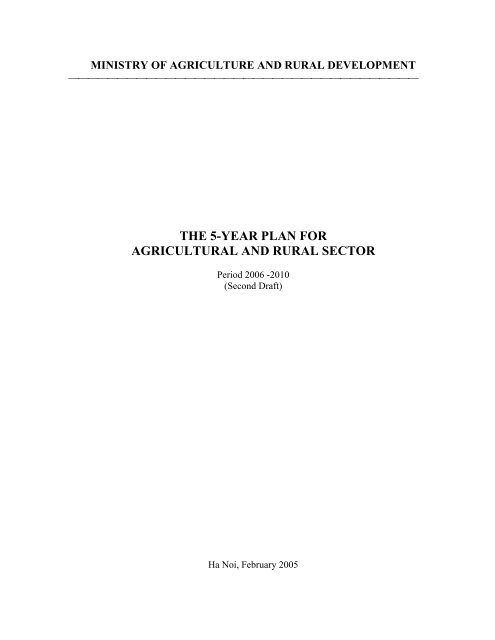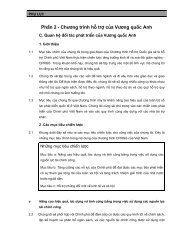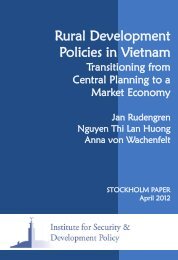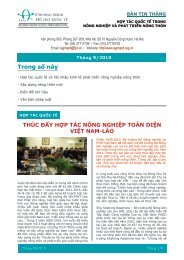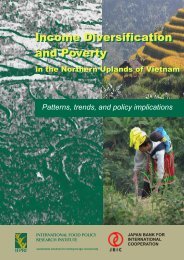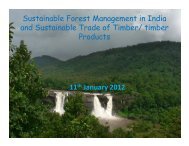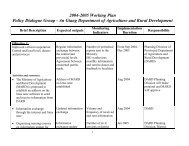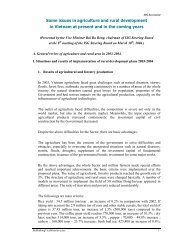the 5-year plan for agricultural and rural sector - International ...
the 5-year plan for agricultural and rural sector - International ...
the 5-year plan for agricultural and rural sector - International ...
You also want an ePaper? Increase the reach of your titles
YUMPU automatically turns print PDFs into web optimized ePapers that Google loves.
MINISTRY OF AGRICULTURE AND RURAL DEVELOPMENT⎯⎯⎯⎯⎯⎯⎯⎯⎯⎯⎯⎯⎯⎯⎯⎯⎯⎯⎯⎯⎯⎯⎯⎯⎯⎯⎯⎯⎯⎯⎯⎯⎯⎯⎯⎯THE 5-YEAR PLAN FORAGRICULTURAL AND RURAL SECTORPeriod 2006 -2010(Second Draft)Ha Noi, February 2005
Table of ContentINTRODUCTION.......................................................................................................................2PART I - SECTOR PERFORMANCE OVER ...........................................................................42001-2005 PERIOD, CHALLENGING FACTORS...................................................................4TO SECTOR DEVELOPMENT IN THE NEXT PERIOD........................................................4I. Sector per<strong>for</strong>mance over <strong>the</strong> last 5 <strong>year</strong> period, 2001-2005............................................41. Implementation of <strong>sector</strong>'s growth <strong>and</strong> development objectives jor <strong>plan</strong>ned targets......42. Mobilization <strong>and</strong> utilization of investment capital in <strong>the</strong> <strong>sector</strong> ...................................93. Annual expenditures by MARD............................................................................... 10II. Shortcomings <strong>and</strong> reasons..............................................................................................10PART II - THE 5 YEAR DEVELOPMENT PLAN FOR AGRICULTURAL AND RURALSECTOR OVER 2006-2010......................................................................................................12I. Influenced factors <strong>and</strong> main considerations <strong>for</strong> building development <strong>plan</strong> <strong>for</strong>agriculture over <strong>the</strong> period 2006-2010 ..................................................................................12II. Development Objectives of Agriculture over 2006-2010 .............................................131. Analyze <strong>and</strong> select <strong>the</strong> development scenario ...........................................................132. Overall objectives......................................................................................................173. Specific objectives <strong>and</strong> priority activities during <strong>the</strong> period 2006-2010...................17III. Identifying priority programs <strong>and</strong> projects <strong>for</strong> investment............................................201. Priority Programs in <strong>the</strong> 5-<strong>year</strong> period from 2006-2010 ...........................................202. Priority projects <strong>for</strong> investment in <strong>the</strong> 5 <strong>year</strong> <strong>plan</strong> to 2010 .......................................25IV. Resources mobilization <strong>and</strong> allocation..........................................................................261. Expectation of capital mobilization <strong>for</strong> whole <strong>sector</strong> development <strong>for</strong> 2006-2010 ..262. Expectation of development investment capital through MARD .............................273. Annual expenditures by MARD over <strong>the</strong> next 5 <strong>year</strong> <strong>plan</strong> .......................................28V. Mechanism of Monitoring <strong>and</strong> Evaluation on implementation of <strong>the</strong> 5 <strong>year</strong> <strong>plan</strong>........281
INTRODUCTIONIn order to implement <strong>the</strong> Prime Minister's Directive No. 33/2004/CT-TTg dated 23September 2004 on building <strong>the</strong> 5-<strong>year</strong> economic - social development <strong>plan</strong> <strong>for</strong> period 2006-2010; guidelines on building 5-<strong>year</strong> economic <strong>and</strong> social development <strong>plan</strong> <strong>for</strong> period 2006-2010 by <strong>the</strong> Ministry of Planning <strong>and</strong> Investment to Ministries, agencies <strong>and</strong> provinces; <strong>the</strong>Ministry of Agriculture <strong>and</strong> Rural Development has been building <strong>the</strong> 5 <strong>year</strong> <strong>plan</strong> <strong>and</strong> issueddocument to its units <strong>and</strong> provincial departments of <strong>agricultural</strong> <strong>and</strong> <strong>rural</strong> development(DARDs) to provide guidelines on implement <strong>the</strong> Prime Minister's Directive.To be fully consistent with Doi Moi policy on economic management of <strong>the</strong>Communist Party <strong>and</strong> Government of Vietnam, <strong>plan</strong>ning will be fur<strong>the</strong>r re<strong>for</strong>med to become areal management tool to monitor <strong>the</strong> economy effectively. The 5 - <strong>year</strong> <strong>plan</strong> is considered asmid-term development strategy in order to identify directions, priority objectives <strong>and</strong> strategicactions to develop <strong>the</strong> economy in <strong>the</strong> next 5 <strong>year</strong> to 2010. In order to base <strong>the</strong> <strong>plan</strong> onscience-evidence <strong>and</strong> with high feasibility, <strong>the</strong> 5 <strong>year</strong> <strong>plan</strong> will be closely linked to mid-termexpenditure framework <strong>and</strong> <strong>the</strong> need of financial mobilization <strong>for</strong> <strong>the</strong> development process notonly be met by government budget but also from o<strong>the</strong>r sources domestically as well asinternational.Building <strong>the</strong> 5-<strong>year</strong> development <strong>plan</strong> of <strong>the</strong> agriculture <strong>sector</strong> <strong>for</strong> <strong>the</strong> period 2006-2010 must meet <strong>the</strong> following main considerations:I. The Mid-term Development Plan of <strong>the</strong> Agriculture <strong>sector</strong> is consistent withdem<strong>and</strong> <strong>for</strong> full <strong>and</strong> comprehensive re<strong>for</strong>m of social-economic activities, closelyrelated to international economic integration <strong>and</strong> trade integration which have beenfostering over <strong>year</strong>s;II.III.IV.Development <strong>plan</strong>ning should streng<strong>the</strong>n <strong>and</strong> improve quality of <strong>for</strong>ecast,particular <strong>for</strong>ecast on economy, markets, science <strong>and</strong> technology… Plan is closelylinked to projections, <strong>sector</strong> development with region development;Plan <strong>and</strong> projection <strong>for</strong> development of <strong>the</strong> <strong>sector</strong>, especially commoditydevelopment <strong>plan</strong>, should cover development of all economic stakeholders, basedon mobilization <strong>and</strong> balance of capital <strong>for</strong> <strong>the</strong> whole <strong>sector</strong> <strong>and</strong> <strong>the</strong> whole country.Development <strong>plan</strong> of <strong>the</strong> <strong>sector</strong> should well incorporate of <strong>the</strong> ComprehensivePoverty Reduction <strong>and</strong> Growth Strategy, Millennium Development Goals (MDGs)<strong>and</strong> commitments of <strong>the</strong> Government of Vietnam to international <strong>and</strong> regionalorganizations;2
V. Building <strong>the</strong> 5-<strong>year</strong> development <strong>plan</strong> <strong>for</strong> 2006-2010 should attach muchimportance to growth quality, competitiveness through improvements of laborproductivity, quality of products <strong>and</strong> reductions of product costs. In <strong>the</strong> 5 <strong>year</strong> <strong>plan</strong>,should concentrate on collect <strong>and</strong> calculate indicators which reflect economicgrowth quality <strong>and</strong> indicators reflecting quality of people's lives, <strong>rural</strong>environmental quality;VI.Increase <strong>the</strong> role of all stakeholders, particular <strong>rural</strong> community, in <strong>plan</strong>ningprocess through consultation, seeking comments widely from domestic <strong>and</strong>international communities. Apply several international st<strong>and</strong>ards <strong>and</strong> calculatingapproaches, methods <strong>for</strong> indicators, which can be collected.The 5 <strong>year</strong> development <strong>plan</strong> <strong>for</strong> agriculture <strong>and</strong> <strong>rural</strong> <strong>sector</strong> include main contents asfollowing:VII. Review per<strong>for</strong>mance of <strong>the</strong> last 5 <strong>year</strong> <strong>for</strong>m 2001-2005;VIII.Analyze domestic <strong>and</strong> international factors which can influence <strong>sector</strong>development during <strong>the</strong> period 2006-2010;IX. Identify objectives <strong>and</strong> priority strategy to develop <strong>the</strong> <strong>sector</strong> <strong>for</strong> period 2006-2010;X. Formulate <strong>and</strong> decide <strong>sector</strong> development <strong>plan</strong>;XI.Forecast bout resource mobilization <strong>and</strong> balance resources <strong>for</strong> developmentinvestment;XII. Policy mechanism <strong>and</strong> resolutions to achieves expected <strong>sector</strong> developmentobjectives;XIII. Mechanism <strong>and</strong> measures to organize monitoring <strong>and</strong> evaluation of <strong>the</strong> 5-<strong>year</strong>development <strong>plan</strong> implementation.3
PART I - SECTOR PERFORMANCE OVER2001-2005 PERIOD, CHALLENGING FACTORSTO SECTOR DEVELOPMENT IN THE NEXT PERIODI. Sector per<strong>for</strong>mance over <strong>the</strong> last 5 <strong>year</strong> period, 2001-20051. Implementation of <strong>sector</strong>'s growth <strong>and</strong> development objectivesThe <strong>sector</strong> 5-<strong>year</strong> development <strong>plan</strong> was implemented in <strong>the</strong> context of variousadversely influencing factors such as <strong>agricultural</strong>ly unfriendly climate, unusual floods <strong>and</strong>storms, widespread occurrence of epidemic diseases to animals <strong>and</strong> crops, particularly <strong>the</strong>avian influenza epidemic. Moreover, <strong>the</strong> world economic <strong>and</strong> market situation was stronglyinfluenced by <strong>the</strong> war in Iraq, leading to highly increased prices of essential materials <strong>for</strong><strong>agricultural</strong> production <strong>and</strong> considerably reduced market <strong>for</strong> <strong>agricultural</strong> products. In thiscontext, <strong>the</strong> Government of Vietnam has guided <strong>the</strong> central Ministries, <strong>sector</strong>s <strong>and</strong> provincesto take relevant measures <strong>for</strong> minimizing adverse impacts, maintaining <strong>the</strong> <strong>agricultural</strong>production <strong>and</strong> contributing to improvements of <strong>the</strong> <strong>rural</strong> population’s life.Implementation results of several major <strong>plan</strong>ned targetsPlannedby 2005Estimatedimplementedvalue%implementedvs. <strong>plan</strong>nedTargetUnitAverage development rate of agro-<strong>for</strong>estryproduction value % 4.3 4.3 100Export of agro-<strong>for</strong>estry products bil. USD 5 4,5 90Average increase of exported agro-<strong>for</strong>estryoutput % 17 16 94Average increase of farmers’ income % 12 10.5 87Annually created new jobs in <strong>rural</strong> areas mil. jobs 0,8 0,8 100Forest coverage % 39 37 95Paddy output mil. tons 33 36,3 110Rice exports mil. tons 4,0 4,0 100Output of various meats mil. tons 2,6 2,8 107.6Proportion of <strong>rural</strong> poor households accordingto national poverty line % 10 7 130Coverage of <strong>rural</strong> clean water supply by 2005 % 65 62 95Proportion of communes with access tonational electric network % 100 90 90Proportion of communes with auto-roads by2005 % 98 98 100Gross investments <strong>for</strong> agro-<strong>for</strong>estry <strong>sector</strong> % 13 9.5 734
The <strong>for</strong>estry sub-<strong>sector</strong> has strongly shifted its activities from <strong>for</strong>est exploitation torestoration-oriented protection of natural <strong>for</strong>ests, leading to a fast growth of new <strong>plan</strong>ted<strong>for</strong>ests of all 3 categories. A strong socialization process has been undertaken in <strong>the</strong> <strong>for</strong>estrysub-<strong>sector</strong>. The existing <strong>for</strong>est resources have been consistently enlarged <strong>and</strong> <strong>the</strong> area of<strong>for</strong>ests of various types has been increased by nearly 1%/<strong>year</strong>. The area of man-made <strong>for</strong>estswas increased by 0.5%/<strong>year</strong> <strong>and</strong> <strong>the</strong> <strong>for</strong>est coverage increased by 1%/<strong>year</strong>, especially reachingto 36.7% in 2004. Forestry developments have recently contributed much to protection <strong>and</strong>conservation of <strong>the</strong> ecological environment, <strong>and</strong> limited bad consequences of unusual <strong>and</strong>unexpected natural disasters over time. The <strong>for</strong>estry sub-<strong>sector</strong> has steadily moved fromexploitation of <strong>the</strong> natural wood <strong>for</strong>ests to exploitation of man-made <strong>for</strong>ests. The output ofexploited natural wood was decreased from 300,000 m 3 in 2000 to 200,000 m 3 in 2004,compared with that of exploited man-made wood, which was increased from 800,000 m 3 toabout 2 million m 3 .The <strong>agricultural</strong> product processing industry <strong>and</strong> <strong>rural</strong> industries have grown upquite well, with <strong>the</strong> weight of <strong>rural</strong> industries <strong>and</strong> services accounting about 40% of <strong>the</strong>regional economy by <strong>the</strong> end of <strong>the</strong> <strong>plan</strong>ning term, <strong>and</strong> <strong>the</strong> average growth rate of 11% on <strong>the</strong>average. At present, <strong>the</strong>re have been totally 2,971 h<strong>and</strong>icraft villages throughout <strong>the</strong> country,providing 1.4 million households working in different areas <strong>and</strong> lines of production. Of thattotal, 2,017 villages are specialized in h<strong>and</strong>icrafts <strong>and</strong> fine arts, using 1.35 million laborers <strong>and</strong>producing a value of around 9,000 bil. VND. Agricultural services have changed significantlyin terms of its <strong>for</strong>ms <strong>and</strong> quality. The added value of <strong>agricultural</strong> services of 1.9%/<strong>year</strong> hascontributed to <strong>the</strong> quantitative <strong>and</strong> qualitative growth of <strong>agricultural</strong> production.The process that <strong>the</strong> <strong>sector</strong>’s production structure is shifted is clearly expressed in<strong>the</strong> improved product quality. In <strong>the</strong> context of increasing quality dem<strong>and</strong>s <strong>for</strong> agro-<strong>for</strong>estryproducts in <strong>the</strong> domestic <strong>and</strong> global market, high-quality varieties of crops <strong>and</strong> breeds ofanimals are increasingly used <strong>for</strong> production, especially <strong>for</strong> agro-<strong>for</strong>estry products to beexported.The <strong>rural</strong> economy over <strong>the</strong> recent <strong>year</strong>s continued to move towards diversifiedproduction to increase <strong>the</strong> weight of processing industry <strong>and</strong> <strong>rural</strong> industries <strong>for</strong> improving<strong>the</strong> added value chain of agro-<strong>for</strong>estry products. Many areas <strong>and</strong> farmers previously involvedin pure <strong>agricultural</strong> production now have moved to diversified production with effective <strong>and</strong>sustainable models. This shifting process has closely linked with <strong>the</strong> labor movement in <strong>rural</strong>areas. The weight of industries in <strong>the</strong> <strong>rural</strong> economy has been increased by 6%, <strong>and</strong> that of<strong>rural</strong> services increased by about 4% while that of agro-<strong>for</strong>estry <strong>and</strong> fishery productsdecreased by around 10%. In many <strong>agricultural</strong> ecological regions, new relevant models arebeing <strong>for</strong>med <strong>and</strong> developed, such as rice-<strong>and</strong>-fish cultivation in <strong>the</strong> Mekong delta, pig farms<strong>and</strong> aquaculture in <strong>the</strong> Red river delta <strong>and</strong> <strong>the</strong> Mekong delta, cow raising combined with<strong>for</strong>estry development in mountainous areas, etc.Consumption of agro-<strong>for</strong>estry products has been improved in both domestic <strong>and</strong>export markets. Facing difficulties relating output <strong>for</strong> <strong>agricultural</strong> products, <strong>the</strong> consumingsystem <strong>for</strong> <strong>agricultural</strong> products has been streng<strong>the</strong>ned on <strong>the</strong> basis of acquiring <strong>and</strong>6
underst<strong>and</strong>ing <strong>the</strong> market in<strong>for</strong>mation, linking production with processing <strong>and</strong> consumption.The export value of agro-<strong>for</strong>estry products over <strong>the</strong> last 5 <strong>year</strong>s has been 16.9 billion USD,<strong>and</strong> <strong>the</strong> average growth rate of <strong>the</strong> export output has reached more than 10%/<strong>year</strong>. Many areas<strong>and</strong> production units have taken <strong>the</strong> first steps to establish trademarks <strong>for</strong> <strong>the</strong>ir <strong>agricultural</strong>products in order to increase <strong>the</strong> competitive capability <strong>and</strong> extend <strong>the</strong> marketing ability. Thesystem of bulk markets <strong>for</strong> <strong>agricultural</strong> products, especially <strong>the</strong> ones in <strong>the</strong> concentrated areasof <strong>agricultural</strong> production, has been established to promote consumption of <strong>agricultural</strong>products. The model of on-line trading of <strong>agricultural</strong> products that has recently emerged hasalso presented good effects.Structural organization <strong>for</strong> <strong>agricultural</strong> production has had changes to fit <strong>the</strong>environment <strong>for</strong> goods production <strong>and</strong> of increasing competitiveness. The privatizationprocess of state-owned enterprises is being promoted. As a result, 191 state-owned enterpriseshave become private, rapidly stabilized <strong>the</strong>ir status <strong>and</strong> effectively developed <strong>the</strong>ir productionactivities. The <strong>for</strong>m of household economy has had some changes in terms of scope <strong>and</strong>quality. So far more than 80,000 households have arranged <strong>the</strong>ir production activities within<strong>the</strong> household farms. The organization of co-operatives has also been re<strong>for</strong>med in terms ofoperational <strong>and</strong> management arrangements. At present, <strong>the</strong>re are 9,255 co-operatives operatingunder new arrangements, including <strong>the</strong> ones that specialize in consuming <strong>agricultural</strong>products.The <strong>rural</strong> infrastructure continued to be upgraded <strong>and</strong> extended, especially <strong>the</strong>irrigation systems, dykes, <strong>rural</strong> electric facilities, clean water supply, <strong>rural</strong> markets, <strong>and</strong>technical <strong>and</strong> service systems. Programs on <strong>rural</strong> infrastructure development, particularlythose <strong>for</strong> poor communes, have significantly improved <strong>the</strong> appearance of <strong>the</strong> <strong>rural</strong> areas <strong>and</strong>rapidly reduced <strong>the</strong> proportion of poor households. Over <strong>the</strong> recent <strong>year</strong>s, <strong>the</strong> irrigation sub<strong>sector</strong>has focused on improving <strong>and</strong> upgrading existing facilities in <strong>the</strong> nor<strong>the</strong>rn provinces,investing in new dams <strong>and</strong> reservoirs in <strong>the</strong> central region <strong>and</strong> Central Highl<strong>and</strong>s; as well asimplementing programs on flood control, fresh water conservation, <strong>and</strong> acidity leaching in <strong>the</strong>Mekong delta. By this time, more than 15,000 km of canals all over <strong>the</strong> country have beenlined, which helped to increase <strong>the</strong> irrigation capacity to over 350,000 ha, ensuring irrigation<strong>for</strong> nearly 90% of <strong>the</strong> cultivated area, <strong>and</strong> facilitating drainage <strong>for</strong> 400,000 ha of l<strong>and</strong>. 98% of<strong>the</strong> communes have had auto-roads connected to <strong>the</strong> communal centers, more than 90% of <strong>the</strong>communes have had access to electricity supplies <strong>and</strong> 62% of <strong>the</strong> <strong>rural</strong> population has hadaccess to clean water supplies <strong>for</strong> domestic uses.Activities <strong>for</strong> poverty reduction in <strong>rural</strong> areas have achieved encouraging results, <strong>the</strong>proportion of poor households has rapidly dropped down, <strong>and</strong> <strong>the</strong> community life in poorcommunes <strong>and</strong> villages has been much improved. Under <strong>the</strong> principle of mobilizing variousresources <strong>for</strong> <strong>rural</strong> poverty reduction, through such programs as Program 135, technicalassistance, <strong>and</strong> loans <strong>for</strong> poverty reduction, <strong>the</strong> proportion of poor <strong>rural</strong> households accordingto <strong>the</strong> national poverty line has reduced to less than 7%. Based on <strong>the</strong> domestic finances <strong>and</strong>funds from international donors <strong>and</strong> organizations, poor people <strong>and</strong> poor communities aremore actively participating in poverty reduction, from <strong>plan</strong>ning poverty reduction programs tosupervising <strong>the</strong> implementation <strong>and</strong> taking initiatives to carry out relating activities.7
2. Mobilization <strong>and</strong> utilization of investment capital in <strong>the</strong> <strong>sector</strong>The investment capital mobilized <strong>for</strong> <strong>the</strong> whole <strong>agricultural</strong> <strong>sector</strong> between 2001 <strong>and</strong> 2004was, on <strong>the</strong> average, 21,786 billion VND per <strong>year</strong>. The highest rate was nearly 24,600 billionVND.Investment capital sources <strong>for</strong> development in <strong>the</strong> <strong>agricultural</strong> <strong>sector</strong>At current prices, billion VNDActual2001Actual2002Actual2003Actual2004Estimated2005 TotalTargetTotal investment capital <strong>for</strong> <strong>the</strong>whole <strong>sector</strong> 18069.1 19705.5 22586.3 24575.0 23997.0 108932.91. State budget (excluding ODAfunds) 3931.2 4122.8 4274.4 5429.0 4490.7 22248.02. State credits <strong>for</strong> investment <strong>and</strong>development 159.0 401.0 410.0 460.0 495.0 1925.03. ODA funds 1170.9 1234.7 931.6 710.8 714.2 4762.24. Investments by enterprises <strong>and</strong> cooperatives(state economy) 8253.0 8503.9 9850.0 10401.6 10640.8 47649.35. Investments by householdeconomy 4025.0 4097.5 4517.4 4612.3 4704.6 21956.76. FDI 524.9 1341.2 2596.5 2953.8 2943.7 10360.27. O<strong>the</strong>r sources 5.1 4.4 6.4 7.5 8.0 31.5The rate of capital mobilization <strong>for</strong> investment <strong>and</strong> development in <strong>the</strong> whole<strong>agricultural</strong> <strong>sector</strong> <strong>for</strong> <strong>the</strong> <strong>plan</strong>ning term 2001-2005 is 30%, at <strong>the</strong> current price, comparedwith <strong>the</strong> added value of agro-<strong>for</strong>estry sub-<strong>sector</strong>s. The growth rate of investment capital <strong>for</strong><strong>the</strong> <strong>agricultural</strong> <strong>sector</strong>’s development is 7.6%/<strong>year</strong>, <strong>and</strong> <strong>the</strong> highest one is 13%. ODA fundsnow have a declining trend, vice versa, FDI tends to increase quite rapidly. Capital mobilizedfrom enterprises <strong>and</strong> households accounts <strong>for</strong> a high proportion <strong>and</strong> tends to steadily increase.The structure of funding sources <strong>for</strong> <strong>the</strong> <strong>agricultural</strong> <strong>sector</strong> is as follow:• From <strong>the</strong> state budget: 20.4%• From state credits <strong>for</strong> investment <strong>and</strong> development: 1.8%• From ODA funds: 4.4%• From domestic enterprises <strong>and</strong> co-operatives: 43.7%• From household economy: 20.2%• FDI: 9.5%Within <strong>the</strong> funding structure <strong>for</strong> development of <strong>the</strong> <strong>agricultural</strong> <strong>sector</strong> during <strong>the</strong> given<strong>plan</strong>ning term, <strong>the</strong> weight of investment capital from enterprises <strong>and</strong> household economyaccounts <strong>for</strong> nearly 64%. This trend substantially con<strong>for</strong>ms to <strong>the</strong> development process of <strong>the</strong>market economy.8
Investments from <strong>the</strong> state budget make up an important part. During <strong>the</strong> <strong>plan</strong>ning term 2001-2004, <strong>the</strong>se investments were increased by 5%/<strong>year</strong>. State budget accounts <strong>for</strong> 94% of publicexpenditures. It has been concentrated in infrastructure construction, support to <strong>the</strong> publicservice system <strong>and</strong> institutional building. At <strong>the</strong> same time, funds from <strong>the</strong> state budget tosubsidize enterprises have been gradually diminished.According to <strong>the</strong> <strong>plan</strong> <strong>for</strong> <strong>the</strong> period 2001-2005, <strong>the</strong> need of investment capital through <strong>the</strong>MARD should be 18,980 billion VND. In fact, <strong>the</strong> actual investment capital was 14,287.9billion VND, i.e. 75.2 % of <strong>the</strong> <strong>plan</strong>ned figure. Out of <strong>the</strong> total development investment capitalmanaged by <strong>the</strong> MARD, domestic funds made up nearly 76.8%, <strong>and</strong> ODA funds accounted <strong>for</strong>23.2%. The investment from <strong>the</strong> budget through <strong>the</strong> MARD was mainly <strong>for</strong> <strong>the</strong> irrigation sub<strong>sector</strong>(accounting <strong>for</strong> nearly 67% of <strong>the</strong> total investment capital through <strong>the</strong> MARD).Analysis of links between <strong>the</strong> investment capital <strong>and</strong> <strong>the</strong> growth rate of <strong>the</strong> whole <strong>sector</strong>’sadded value shows that on <strong>the</strong> average, <strong>the</strong> investment capital <strong>for</strong> <strong>the</strong> <strong>agricultural</strong> <strong>sector</strong> (at <strong>the</strong>1994 fixed price) is equal to 30%. This ratio is quite good. However, <strong>the</strong> investment efficiencymeasured by GDP as an indicator is fairly low, partly because a part of <strong>the</strong> investment capital<strong>for</strong> <strong>the</strong> <strong>sector</strong> is not merely <strong>for</strong> promoting growth of <strong>the</strong> economic value (as investments in<strong>for</strong>est development, environmental <strong>and</strong> natural resources protection as well as in irrigation arepartly <strong>for</strong> non-<strong>agricultural</strong> benefits). Ano<strong>the</strong>r cause <strong>for</strong> low efficiency of investments is that<strong>the</strong> ability of funding source selection <strong>and</strong> allocation as well as capital management <strong>and</strong>utilization is still limited.The investment capital from ODA funds in <strong>the</strong> <strong>plan</strong>ning term tended to decline, <strong>and</strong> especiallyconsiderably reduced compared with that in <strong>the</strong> 1990s. There are many reasons <strong>for</strong> thissituation: reduced grants <strong>and</strong> proportion of grants, increased proportion of concessionaryloans, increased FDI, <strong>and</strong> tightened procedures <strong>for</strong> ODA fund mobilization. This situation hasled to <strong>the</strong> fact that <strong>the</strong> commitment level on ODA is high, but capacities of responsibleagencies <strong>for</strong> investment preparation <strong>and</strong> disbursement are still weak, making <strong>the</strong>implementation of ODA commitments lower than undertaken by <strong>the</strong> donors.Of <strong>the</strong> gross investment capital <strong>for</strong> socio-economic development in <strong>the</strong> <strong>plan</strong>ning term 2001-2005 (around 185,000 billion VND/<strong>year</strong>), investments <strong>for</strong> <strong>the</strong> <strong>agricultural</strong> <strong>sector</strong> account <strong>for</strong>nearly 11% - 12%.3. Annual expenditures by MARDTotal expenditures from <strong>the</strong> MARD’s budget between 2001 <strong>and</strong> 2005 are about 3,770.7 billionVND, of which:Recurrent expenditures: 3,232.6 billion, accounting <strong>for</strong> 97.3%Expenditures <strong>for</strong> national target programs: 122.2 billion (i.e. 3.1%)O<strong>the</strong>r expenditures: 250.5 billion (i.e. 6.6%)9
The recurrent expenditures from 2001 to 2004 increased, on <strong>the</strong> average, by 15% a <strong>year</strong>.However, those <strong>for</strong> 2005 are expected to be decreased. Recurrent expenditures are often used<strong>for</strong> main activities, such as:Expenditures <strong>for</strong> non-profitable economic activities: 36.4%Expenditures <strong>for</strong> scientific research: 29.3%Expenditures <strong>for</strong> training: 29.5%Expenditures <strong>for</strong> administration: 4.3%O<strong>the</strong>r expenditures: 0.5%II. Shortcomings <strong>and</strong> reasonsOver <strong>the</strong> 5 <strong>year</strong>s implementing <strong>the</strong> <strong>plan</strong>, <strong>the</strong> <strong>agricultural</strong> <strong>sector</strong> has maintained a quitegood growth rate, <strong>and</strong> shifted <strong>the</strong> <strong>sector</strong>’s production structure towards <strong>the</strong> market <strong>and</strong> inlinkage with poverty reduction <strong>and</strong> social equity targets <strong>for</strong> <strong>rural</strong> areas. However, <strong>the</strong> growthprocess in general is not yet sustainable <strong>and</strong> of good quality. Moreover, efficiency ofproduction activities <strong>and</strong> <strong>the</strong> competitive ability of <strong>the</strong> <strong>sector</strong> are still fairly limited. There aremany reasons <strong>for</strong> that situation. On <strong>the</strong> one h<strong>and</strong>, <strong>the</strong> climatic conditions are unfavorable, <strong>and</strong><strong>the</strong> socio-economic environment in <strong>and</strong> outside <strong>the</strong> country is ra<strong>the</strong>r changeable. On <strong>the</strong> o<strong>the</strong>rh<strong>and</strong>, <strong>the</strong> <strong>sector</strong>’s capacity of organizing <strong>and</strong> operating production activities is still weak.The <strong>rural</strong> <strong>agricultural</strong> economy has had movements though at a ra<strong>the</strong>r low speed;<strong>the</strong> movements are not yet towards quality, sustainability <strong>and</strong> intensiveness; <strong>and</strong> manyprovinces have not yet been able to identify orientations <strong>for</strong> <strong>the</strong>ir own movements. Asignificant constraint to <strong>the</strong> growth of Vietnam’s <strong>agricultural</strong> <strong>sector</strong> is <strong>the</strong> competitive abilityof <strong>agricultural</strong> products both in terms of price <strong>and</strong> quality, while <strong>the</strong> shifting process so far hasbeen quite extensive, ra<strong>the</strong>r than strongly oriented to increased quality <strong>and</strong> reduced price.Agricultural science <strong>and</strong> technologies have made important contributions to<strong>agricultural</strong> growth. However, <strong>the</strong>y have not yet become a major trigger to promote growth<strong>and</strong> development of <strong>agricultural</strong> production in <strong>the</strong> context of <strong>the</strong> developing marketeconomy <strong>and</strong> increasing globalization. Although Vietnam has become a large exporter of<strong>agricultural</strong> products, its product quality is ra<strong>the</strong>r low compared with that of o<strong>the</strong>r countries in<strong>the</strong> region, <strong>the</strong> cost price of almost <strong>agricultural</strong> products is still high, <strong>and</strong> most of exporteditems are ei<strong>the</strong>r unprocessed or preliminarily processed. In fact, Vietnam has very littlecollections of crop varieties or animal breeds to make <strong>agricultural</strong> products of recognizabletrademarks.In <strong>the</strong> current competitive commodity agriculture, Vietnam's <strong>agricultural</strong> <strong>sector</strong> hasnot yet been able to make suitable arrangements <strong>for</strong> production, which should prove to beeffective <strong>and</strong> competitive within <strong>the</strong> <strong>sector</strong>. The process of producing goods requires a closelink between <strong>the</strong> material producing phase <strong>and</strong> <strong>the</strong> processing <strong>and</strong> consuming process.Never<strong>the</strong>less, <strong>the</strong> current link between farmers, processors <strong>and</strong> consumers is very loose; <strong>and</strong>responsibilities <strong>and</strong> rights are inadequately addressed in <strong>the</strong> <strong>sector</strong>.10
In spite of recent renovations in investment <strong>plan</strong>ning, <strong>the</strong>re are still limitations ininvestment management; moreover, <strong>the</strong> process of selecting <strong>and</strong> allocating investment fundsis not sufficiently tight <strong>and</strong> effective. Unsound management of investments has led to debts incapital construction investments. The debts sometimes exceed 1,000 billion VND. Lack ofbalance between capital investment, recurrent working capital <strong>and</strong> production capital hasinduced <strong>the</strong> fact that infrastructure, equipment <strong>and</strong> facilities are wastefully used. A lot ofinfrastructure, equipment <strong>and</strong> research facilities have high designed capacity but are onlyoperated at a very low rate. This is a tremendous waste, supplemented by <strong>the</strong> wastes caused bylosses in capital investments, leading to a low level of investment efficiency.Agricultural policies <strong>and</strong> institutions have not been timely revised <strong>and</strong> amended tomeet new development needs. A lot of introduced policies appeared to be very infeasible dueto many reasons, of which <strong>the</strong> most major ones are lacks of resources <strong>and</strong> goodimplementation arrangements. It can be easily noted that one of <strong>the</strong> major constraints toVietnam's agriculture is <strong>the</strong> small size of farml<strong>and</strong>/household l<strong>and</strong>, while <strong>the</strong>re is a high rate ofsurplus <strong>rural</strong> labor. This situation is hindering investments <strong>for</strong> application of moderntechnologies to bring <strong>agricultural</strong> products of equally good quality. On <strong>the</strong> o<strong>the</strong>r h<strong>and</strong>, <strong>the</strong>small scope <strong>and</strong> scattered allocation of <strong>agricultural</strong> production activities have causeddifficulties to organizing a link between material producers <strong>and</strong> factories, <strong>and</strong> between creditlenders <strong>and</strong> producers who are in need of capital.The system of <strong>rural</strong> technical <strong>and</strong> social services is inadequate <strong>and</strong> characterized bylimited quality; producers <strong>and</strong> <strong>rural</strong> population still meet difficulties in accessing toservices. Services are not fully <strong>and</strong> timely provided, especially services <strong>for</strong> <strong>agricultural</strong>extension, or services <strong>for</strong> providing market in<strong>for</strong>mation as well as knowledge <strong>and</strong> skills onproduction management in <strong>the</strong> market economy have not caught up with dem<strong>and</strong>s of <strong>the</strong>economy. It made producers fail to make right <strong>and</strong> effective choices.Labor movements <strong>and</strong> job creation in <strong>the</strong> <strong>agricultural</strong> <strong>and</strong> <strong>rural</strong> <strong>sector</strong> are stillra<strong>the</strong>r low, inducing delayed improvements of <strong>the</strong> <strong>rural</strong> population's income. In fact, <strong>the</strong><strong>rural</strong> <strong>sector</strong> is mainly relying on <strong>agricultural</strong> production. However, <strong>the</strong> labor productivity isstill low, labor time currently used in <strong>rural</strong> areas is accounting <strong>for</strong> only 75% of <strong>the</strong> totalavailable time. On <strong>the</strong> o<strong>the</strong>r h<strong>and</strong>, more than 1 million new <strong>rural</strong> laborers are included in <strong>the</strong>social labor <strong>for</strong>ce <strong>and</strong> <strong>the</strong>y apparently need jobs <strong>for</strong> <strong>the</strong>ir livelihood.The administrative re<strong>for</strong>m program has been launched, however, its progress isra<strong>the</strong>r low <strong>and</strong> results are limited; training technical specialists, management staff <strong>and</strong>employees in <strong>the</strong> <strong>sector</strong> is not yet relevant. The re<strong>for</strong>m process <strong>for</strong> <strong>the</strong> economic managementmechanism is presently facing an impediment made by <strong>the</strong> <strong>sector</strong>'s state managementagencies. It is partly because <strong>the</strong> state management staff is failing to improve <strong>the</strong>irqualifications in accordance with <strong>the</strong> dem<strong>and</strong>s of <strong>the</strong> market economy, <strong>and</strong> partly because ofinappropriate organizational structure of state management agencies as well as existingoverlaps in responsibilities <strong>and</strong> functions. Some state management agencies still want tointerfere in <strong>the</strong> decision making process of businesses, on <strong>the</strong> contrary, many issues thatshould be addressed within <strong>the</strong> functions <strong>and</strong> m<strong>and</strong>ate of state management agencies are left tobe stuck.11
PART II - THE 5 YEAR DEVELOPMENT PLAN FORAGRICULTURAL AND RURAL SECTOR OVER 2006-2010I. Influenced factors <strong>and</strong> main considerations <strong>for</strong> building development<strong>plan</strong> <strong>for</strong> agriculture over <strong>the</strong> period 2006-20101. Background <strong>and</strong> challenges:The period 2006-2010 will have 2 major events, which can greatly affect Vietnam'seconomy in general, <strong>and</strong> <strong>the</strong> <strong>agricultural</strong> <strong>sector</strong> in particular: (i) Vietnam will potentially join<strong>the</strong> World Trade Organization by <strong>the</strong> end of 2005, (2) <strong>the</strong> Asean Free Trade Area (AFTA) willbe fully implemented by 2006.The globalization process will surely lead to fierce competition, while <strong>the</strong> Vietnam'sagriculture is facing several major challenges, which should be overcome in coming <strong>year</strong>s:(1) Labor productivity in agriculture is very low while cultivated l<strong>and</strong> is limited <strong>and</strong>scales of l<strong>and</strong> plots of production units are small which greatly constrain <strong>the</strong>process of production reorganization to be more suitable as well as investment onhigh technologies to improve competitiveness in <strong>the</strong> integration process into <strong>the</strong>world markets <strong>and</strong> economies;(2) Surplus of labor in <strong>rural</strong> areas, dem<strong>and</strong> <strong>for</strong> employment of <strong>rural</strong> labor isincreasing, move of <strong>agricultural</strong> labor into o<strong>the</strong>r non-farm activities is main wayto increase labor productivity <strong>and</strong> incomes of farmers <strong>and</strong> <strong>rural</strong> households;(3) The competitiveness of Vietnam's <strong>agricultural</strong> commodities is low due touncompetitive prices <strong>and</strong> quality, <strong>the</strong>se two constraints are all rooted on <strong>the</strong> factthat <strong>agricultural</strong> science <strong>and</strong> technology is limited not only in production stagebut also in processing <strong>and</strong> marketing. In fact, possibility <strong>for</strong> expansion of scalesof <strong>agricultural</strong> production is remained large but meet bottleneck in consumption<strong>and</strong> market. Based on market economic point of view, <strong>the</strong>re are several farmproducts, which are burdened by surplus (supply is more than dem<strong>and</strong>).(4) The gap between <strong>rural</strong> incomes <strong>and</strong> urban incomes seems to be increasing whichlead to capital accumulation in <strong>agricultural</strong> <strong>sector</strong> <strong>for</strong> investment is limited.Poverty incidence in <strong>rural</strong> areas accounts <strong>for</strong> about 90% of <strong>the</strong> total povertyhouseholds over <strong>the</strong> country.(5) There is lack of appropriate policies to attract resources from various sources toinvest into <strong>the</strong> agriculture-<strong>rural</strong> <strong>sector</strong> such as from government budget,enterprises, <strong>and</strong> abroad (ODA <strong>and</strong> FDI).12
2. Main considerations <strong>for</strong> building 5 <strong>year</strong> development <strong>plan</strong> <strong>for</strong> <strong>the</strong> next period:- Consider <strong>the</strong> development of agriculture in period 2006-2010 within presence ofinternational economic integration <strong>and</strong> fierce competition on Vietnam's domesticmarket;- Action Strategy should concentrate on address constraints mentioned in previoussection, among which should consider science - technology <strong>and</strong> market resolutionsis <strong>the</strong> main driven <strong>for</strong>ce;- There should be specific priorities between investment on intensive commercial<strong>agricultural</strong> production to increase <strong>the</strong> growth rate, improve <strong>the</strong> whole <strong>sector</strong>'scompetitiveness <strong>and</strong> investment on self-sufficient <strong>agricultural</strong> production topromote rapid poverty reduction in disadvantaged areas due to constraints inresources;- The 5 - <strong>year</strong> Agricultural Development Plan <strong>for</strong> 2006-2010 should be based onlong term social-economic development strategy of Vietnam <strong>and</strong> <strong>the</strong> SustainableDevelopment Strategy (21 Agenda Program) which Vietnam already commit to <strong>the</strong>international community;- Sector's development objectives should be balanced with financial resources, <strong>the</strong>seresources should be mobilized <strong>and</strong> balanced from 4 major sources: (i) enterprises;(ii) households (<strong>and</strong> small private units); (iii) government's budget, <strong>and</strong> (iv)committed international financed sources; <strong>and</strong>- Policies <strong>and</strong> programs to implement <strong>the</strong> 5 <strong>year</strong> <strong>plan</strong> with specified objectivesshould be highly feasible which means that <strong>the</strong>se policies should be met withadequate resources to implement <strong>and</strong> a mechanism <strong>for</strong> monitoring <strong>and</strong> evaluation,indicators to monitor <strong>the</strong> <strong>plan</strong> should be developed.II. Development Objectives of Agriculture over 2006-20101. Analyze <strong>and</strong> select <strong>the</strong> development scenarioFrom <strong>the</strong> review of <strong>the</strong> <strong>sector</strong> per<strong>for</strong>mance over <strong>the</strong> last five <strong>year</strong>s 2001-2005 <strong>and</strong> <strong>the</strong>real situation of Vietnam's agriculture at <strong>the</strong> moment, it is recognized that <strong>the</strong> potential <strong>for</strong><strong>agricultural</strong> growth is still quite large, which can be reflected by following aspects:• Labor in agriculture <strong>and</strong> <strong>rural</strong> <strong>sector</strong> is quite redundant, which means that creatingnew jobs will accelerate growth rate;13
• There is still good potential <strong>for</strong> increasing <strong>agricultural</strong> production throughincreasing cultivated areas <strong>and</strong> improving yields;• Resources invested in agriculture, especially financial resource are low but <strong>the</strong>re islarge amount of resources which has not been fully mobilized, such as l<strong>and</strong>resource, capital of households <strong>and</strong> enterprises;These potentialities have not been fully realized to increase agriculture growth rate dueto several major constraints, which are:• Expansion of market is limited because of low competitiveness of several farmproducts <strong>and</strong> marketing capability of <strong>the</strong> <strong>sector</strong> is constrained. Consequently,increased competitiveness which will open fur<strong>the</strong>r market <strong>for</strong> Vietnam's farmproducts will be an important strategy to help exp<strong>and</strong>ing production in comingtime. At <strong>the</strong> moment in <strong>the</strong> world market <strong>for</strong> certain farm products, supply isovercoming dem<strong>and</strong>, <strong>the</strong> global market increasingly dem<strong>and</strong>s high qualityproducts, especially <strong>the</strong> need <strong>for</strong> product safety; on <strong>the</strong> o<strong>the</strong>r h<strong>and</strong>, many countrieswill use technical non-tariff barriers to constrain farm import. Meanwhile, <strong>the</strong>domestic market is much more competitive when Vietnam fully integrate into <strong>the</strong>world trade system;• Increase scale <strong>and</strong> space of application of science <strong>and</strong> technology into <strong>agricultural</strong>production in order to make <strong>agricultural</strong> science <strong>and</strong> technology a major driven<strong>for</strong>ce to accelerate growth in agriculture <strong>and</strong> <strong>rural</strong> <strong>sector</strong> <strong>for</strong> coming <strong>year</strong>s. At <strong>the</strong>moment, <strong>agricultural</strong> research <strong>and</strong> science <strong>and</strong> technology transfer is notsystematic, <strong>the</strong>re is a lack of close relationship between research institutions <strong>and</strong>technical transfer units in order to solve <strong>the</strong> big issue at <strong>the</strong> moment of <strong>the</strong><strong>agricultural</strong> <strong>sector</strong>, that is production must be based on market dem<strong>and</strong> <strong>and</strong> signals.To better address science <strong>and</strong> technology issue will be <strong>the</strong> basic factor which c<strong>and</strong>rive <strong>agricultural</strong> growth sustainably in coming <strong>year</strong>s. Investment in science <strong>and</strong>technology <strong>and</strong> technical transfer is considered <strong>the</strong> most effective investment incomparison with investment in o<strong>the</strong>r areas within <strong>the</strong> <strong>agricultural</strong> <strong>sector</strong>. But in <strong>the</strong>last couple of <strong>year</strong>s, proportion of investment in science <strong>and</strong> technology is still low,<strong>the</strong>re is lack of investment in well selected projects which can create majorbreakthrough to address quickly <strong>the</strong> <strong>sector</strong>'s major constraints;• Mobilization <strong>and</strong> usage of capital in <strong>agricultural</strong> <strong>sector</strong> is ineffective, <strong>the</strong>re shouldbe adjustments of investment in agriculture as well as management of investmentcapital more closely in order to improve effectiveness of investment (<strong>the</strong> wholeeconomy now is wasting more than 15% of <strong>the</strong> total investment capital which is14
higher than <strong>the</strong> growth rate of investment capital annually). Data fromimplementation of development <strong>plan</strong> shows that <strong>the</strong> ICOR is very high <strong>for</strong><strong>agricultural</strong> <strong>sector</strong> as well as <strong>the</strong> whole economy, which means that Vietnam willneed very high increase in investment capital in order to create fur<strong>the</strong>r growth. Thehigh ICOR means that <strong>the</strong> effectiveness of investment in agriculture is low, capitalis being wasted <strong>and</strong> <strong>the</strong> effectiveness of usage of fixed assets is low. In order toremain healthy <strong>and</strong> sustainable growth rate of <strong>the</strong> <strong>agricultural</strong> <strong>sector</strong>, <strong>the</strong> rate ofinvestment <strong>for</strong> <strong>the</strong> whole <strong>sector</strong> should be more than 30% of <strong>the</strong> <strong>sector</strong>'s total valueadded. Among three main objectives <strong>for</strong> <strong>agricultural</strong> development over <strong>the</strong> nextperiod, it should be concentrated on increasing investment effectiveness in order toincrease value added chains of farm products as well as <strong>agricultural</strong> services;• From <strong>the</strong> point of view of <strong>the</strong> overall national economy, in <strong>the</strong> next period <strong>the</strong>economy's resources should be concentrated on industrialization <strong>and</strong> modernizationof <strong>the</strong> economy, industry <strong>and</strong> service are two areas which should be priority <strong>for</strong>investment in order to increase growth rate highly, among which three economicdriven centers of <strong>the</strong> country will be priority to become <strong>the</strong> lead of <strong>the</strong> wholeeconomy. Agricultural <strong>sector</strong> should enjoy stable growth to be a base <strong>for</strong> industry<strong>and</strong> service to accelerate. Increased growth rates of industry <strong>and</strong> services willcreate more new jobs <strong>and</strong> attract labor from <strong>agricultural</strong> <strong>sector</strong> at a higher speedwhich can, <strong>the</strong>re<strong>for</strong>e, increase <strong>rural</strong> incomes.• Vietnam's <strong>agricultural</strong> <strong>and</strong> <strong>rural</strong> <strong>sector</strong> is characterized by several main aspects: (i)<strong>rural</strong> economy is based mainly on <strong>agricultural</strong> production; (ii) agriculturecontributes to 75-80%; within <strong>the</strong> <strong>agricultural</strong> <strong>sector</strong>, proportion of crops is morethan 75%. With <strong>the</strong>se structures, <strong>the</strong> move from crops to animal husb<strong>and</strong>ry <strong>and</strong>services within 5 <strong>year</strong>s will not be significant; since in order to increase proportionof animal husb<strong>and</strong>ry by 1% in <strong>the</strong> total <strong>agricultural</strong> GDP will need an increase of16% of <strong>the</strong> animal husb<strong>and</strong>ry's added value, while <strong>the</strong> service will need to increaseby 40% in term of added value. It all means that at <strong>the</strong> current <strong>agricultural</strong>structure, to increase proportion of animal husb<strong>and</strong>ry from 20% to 30% will need<strong>the</strong> growth rate of <strong>the</strong> animal husb<strong>and</strong>ry by 160%, which is impossible.Consequently, <strong>the</strong> direction <strong>for</strong> changes in <strong>the</strong> agriculture structure throughimproved product's quality, increased processing level of farm products, increasedcommercial rate of farm products <strong>and</strong> increased export proportion of farmproduction, which means to make <strong>agricultural</strong> grown in deep, will be more feasible<strong>and</strong> practical. On o<strong>the</strong>r h<strong>and</strong>, in <strong>the</strong> market economy production's profits or valueadded is <strong>the</strong> most important target of producers <strong>and</strong> <strong>the</strong> economy, not <strong>the</strong>production value.15
• To make <strong>agricultural</strong> growth sustainably will need to have harmonious balancebetween poverty reduction in <strong>rural</strong> <strong>and</strong> protection of natural resources <strong>and</strong> ecologicenvironment. At <strong>the</strong> moment, <strong>the</strong>re are about 90% of <strong>the</strong> total poor householdsliving in <strong>rural</strong> areas, especially in mountainous areas, steep hill, areas with more<strong>for</strong>estry resources. If <strong>the</strong> poverty in <strong>the</strong> mountainous areas with large river basincannot be solved <strong>the</strong>n damage to <strong>for</strong>estry resources, environmental imbalance inimportant areas will not be stopped. This is a risk which can lead to unstableeconomic growth <strong>the</strong>n it should be addressed quicklyThere are three scenarios <strong>for</strong> <strong>sector</strong> development which should be considered:Scenarios Monitoring indicators CapitalrequirementScenario 1: Growth rate of <strong>the</strong> <strong>agricultural</strong> <strong>sector</strong>is high. Level of capital mobilization <strong>for</strong>industrialization of agriculture is high,concentrating on commercial <strong>agricultural</strong>production, investment on science <strong>and</strong> technologyto reduce production costs <strong>and</strong> increase farmproducts' quality with priority <strong>for</strong> exported farmproductsScenario 2: Growth rate of <strong>agricultural</strong> <strong>sector</strong> isrelatively high. Appropriate level of capitalmobilization, adjustments in investment structureaiming at improved effectiveness, give priority toinvestment in concentrated <strong>agricultural</strong>production areas, processing <strong>and</strong> marketing offarm products with a appropriate consideration <strong>for</strong>investment in poor areasScenario 3: Growth rate of <strong>agricultural</strong> <strong>sector</strong> islimited. The level of capital mobilization is <strong>the</strong>same with last 5 <strong>year</strong>'s level, equal investment inboth commercial <strong>agricultural</strong> production <strong>and</strong> selfsufficientagriculture with priority given to poorareas. The global economy <strong>and</strong> trade is notfavorableGrowth rate of <strong>the</strong> farm<strong>sector</strong>: 3.6-3.7%,specifically:- Agriculture: >3.7%:- Forest: 3.2;- Agro-services: >5.8%;- Rural poverty rate:> 5%Growth rate of <strong>the</strong> farm<strong>sector</strong>: 3.4-3.5%,specifically:- Agriculture: 3.4-3.5%:- Forest: 3.5-3.6;- Agro-services: 5.4%;- Rural poverty rate: < 5%Growth rate of <strong>the</strong> farm<strong>sector</strong>: 3.0-3.3%,specifically:- Agriculture: 3-3.3%:- Forest: 2.9-3.2;- Agro-services: 4-4.5%;- Rural poverty rate: 156thous<strong>and</strong>billions dong146thous<strong>and</strong>billions dong135thous<strong>and</strong>billions dongConsidering every scenario will show that <strong>the</strong> Scenario 1 with high growth will needhigh level of capital mobilization but it will not meet <strong>the</strong> comprehensive poverty reduction <strong>and</strong>growth strategy's objectives at <strong>the</strong> national level. On o<strong>the</strong>r h<strong>and</strong>, even though <strong>the</strong> high level of16
capital mobilization <strong>for</strong> this Scenario might be achieved but <strong>the</strong> capacity of investmentpreparation, capital usage <strong>and</strong> implementation management at <strong>the</strong> moment will not be able toh<strong>and</strong>le effectively.With consideration on feasibility of each scenario, it is recognized that <strong>the</strong> Scenario 2(reasonable growth rate) has <strong>the</strong> highest feasibility, <strong>and</strong> suitable to <strong>the</strong> overall objectives ofnational socio-economic development. As <strong>the</strong> result, <strong>the</strong> following sections is analyzed basedon <strong>the</strong> Reasonable Growth Rate Scenario.The Scenario 3 with low growth rate will not meet <strong>the</strong> objectives of <strong>the</strong> strategy toincrease competitiveness of <strong>the</strong> <strong>sector</strong> in order to be integrated successfully, than it will make<strong>the</strong> <strong>sector</strong> lagged behind that of o<strong>the</strong>r countries.2. Overall objectivesTo develop market - oriented <strong>agricultural</strong> <strong>sector</strong> with social orientation to increaseincomes <strong>and</strong> improve people's lives in <strong>agricultural</strong> <strong>and</strong> <strong>rural</strong> <strong>sector</strong>, to protect natural resources<strong>and</strong> ecologic environment. Agricultural development in <strong>the</strong> next period should achieve highvalueadded, improved competitiveness <strong>and</strong> effective production. Overall objectives are:• Agricultural households' income on average increases by 10-12% per <strong>year</strong>, toincrease by two folds by 2010 in comparison with 2000's level;• Rural poverty rate is less than 5 percent based on national poverty st<strong>and</strong>ard (<strong>and</strong>less than 15 percent based on international poverty st<strong>and</strong>ards).• Agricultural growth is quality <strong>and</strong> sustainable.3. Specific objectives <strong>and</strong> priority activities during <strong>the</strong> period 2006-2010The 5-<strong>year</strong> <strong>sector</strong> development <strong>plan</strong> identifies 3 main objectives that should beachieved to realize <strong>the</strong> overall objectives of <strong>the</strong> <strong>sector</strong> during <strong>the</strong> development period from2006 to 2010. With a point of view that <strong>the</strong> economy's resources are limited, <strong>the</strong>re are toomany things to do but in <strong>the</strong> next 5 <strong>year</strong> in order to invest effectively, <strong>the</strong>re should be priorityactivities in order to achieve <strong>the</strong> three main objectives.Poverty reduction should be always linked to quality growth, which will greatly affectpoverty reduction in <strong>rural</strong> areas, to solve poverty issue in <strong>the</strong> <strong>rural</strong> areas by both ways: (i)invest to support directly <strong>the</strong> poor; <strong>and</strong> (ii) invest into <strong>sector</strong>s, regions from which <strong>the</strong> poor canget benefit greatly.17
Objectives Priority Activities Monitoring Indicators1. To maintain<strong>sector</strong>'s growthrate sustainablywith quality- Accelerate industrialization <strong>and</strong>modernization of <strong>agricultural</strong> <strong>sector</strong>. Torestructure production of crops <strong>and</strong>animal husb<strong>and</strong>ry, to give priority toinvestment in science <strong>and</strong> technology, tocreate varieties with improved yield <strong>and</strong>quality <strong>for</strong> major crops which areclosely related to processing in order toincrease value added chains- Concentratively invest in processing<strong>and</strong> post-harvest science <strong>and</strong> technologyto increase product's value <strong>and</strong>competitiveness.- Increased investment in tradepromotion <strong>and</strong> <strong>agricultural</strong> marketing toexp<strong>and</strong> <strong>and</strong> maintain domestic market<strong>and</strong> export.- To establish suitable <strong>and</strong> wellorganizedproduction model based onimproved l<strong>and</strong> policies, to facilitateinvestment in technology, to improveeffectiveness <strong>and</strong> competitiveness, toincrease product's quality <strong>for</strong> processing<strong>and</strong> <strong>for</strong> export with competitive prices.- To improve economic infrastructure tosupport agriculture with improvedmanagement <strong>and</strong> operation;- Re<strong>for</strong>m l<strong>and</strong> policies <strong>and</strong> accelerateequitization of state-owned enterprises- Maintain production volume of38-38.9 million tons of paddy;- Growth rate of <strong>agricultural</strong><strong>for</strong>estryGDP is 3.4-3.5%annually;- Structure of <strong>agricultural</strong><strong>for</strong>estryGDP by 2010 (based on2005's price level) is agriculture95,5%, <strong>for</strong>estry 4,5%.Within agriculture:- crops: 73,8%,- animal husb<strong>and</strong>ry: 24%- agro-services: 2,2%.- Value added per l<strong>and</strong> unitincreases by 1.45 folds incomparison with 2005 level;- Value added per labor-laborincrease by 1.35-1.4 folds incomparison with 2005 level;- Commercial rate of <strong>agricultural</strong>production: 60%;- Processing rate of <strong>agricultural</strong>products is 70-80%, amongwhich 30-40% is highlyprocessed;- Value added from processing:…;- Growth rate of <strong>agricultural</strong><strong>for</strong>estryexport turnovers is morethan 10% annually;- Rate of <strong>agricultural</strong> export ontotal <strong>agricultural</strong> production18
2, To improvesignificantlysocialenvironment in<strong>rural</strong> areas3. Protectnaturalresources <strong>and</strong>ecologicalenvironment<strong>and</strong> improvelivingenvironment<strong>for</strong> <strong>rural</strong> people- Increase quality of human resources<strong>and</strong> use resources in <strong>agricultural</strong> <strong>and</strong><strong>rural</strong> <strong>sector</strong> through development ofvocational training systems in <strong>rural</strong>areas, a extension system to givetraining on transferring technical,economic <strong>and</strong> production managementknowledge, on market knowledge <strong>and</strong>in<strong>for</strong>mation;- Concentratively invest in <strong>rural</strong> trainingon non-farm activities, particularly on<strong>agricultural</strong> processing, h<strong>and</strong>y craft,small industries <strong>and</strong> <strong>agricultural</strong>services;- Create <strong>agricultural</strong> <strong>and</strong> non-farm jobsin order to accelerate <strong>the</strong> movement oflabor from agriculture to non-farm<strong>sector</strong>s as it being considered as <strong>the</strong>major movement to increase <strong>rural</strong>incomes; <strong>and</strong>- Rapidly improve social infrastructuresystem in <strong>rural</strong> areas, increase <strong>rural</strong>people's access to all social - welfareservices.- Invest on maintain <strong>for</strong>estry resources<strong>and</strong> develop <strong>for</strong>estry areas, to link<strong>for</strong>estry development with benefits <strong>for</strong><strong>for</strong>est management people;- Well exploit <strong>and</strong> manage waterresources to provide adequate water <strong>for</strong>production <strong>and</strong> living in <strong>rural</strong> areas;- Stop over-exploitation of naturalresources in order to reduce damage toenvironmentvalue is more than 60%.- Poverty rate is less than 5%- Rate of used potential laborhours <strong>for</strong> <strong>rural</strong> labor is more than90%;- Rate of <strong>agricultural</strong> <strong>and</strong> <strong>for</strong>estrylabor receiving training is morethan 30%;- 100% of farmers have access toextension services;- Create new jobs <strong>for</strong> 70% of<strong>rural</strong> new labor added to <strong>the</strong>work<strong>for</strong>ce every <strong>year</strong>, amongwhich: in <strong>agricultural</strong> <strong>sector</strong>:60%, non-farm <strong>sector</strong>s: 40%.- The rate of movement of<strong>agricultural</strong> labor to non-farm<strong>sector</strong> is 5-8%;- 100% of all communes havepost offices, cultural places togive access to technical <strong>and</strong>market in<strong>for</strong>mation to <strong>rural</strong>people.- Rate of <strong>for</strong>estry coverage isfrom 43% to 44%;- Rate of <strong>rural</strong> households usingclean water is 87%;- Rate of <strong>rural</strong> households havingclean bathroom <strong>and</strong> latrine is70%.4. Effective - Re<strong>for</strong>m of <strong>the</strong> organization system of - 100% of all <strong>sector</strong>'s state19
<strong>and</strong> dynamic<strong>sector</strong>'smanagementsystemstate management of <strong>the</strong> <strong>sector</strong>;- Training to increase capacity ofmanagement staff to be able to meetrequirements of market economy;- Restructure of management agenciesas well as research <strong>and</strong> public servicesystem;- Formulate new policies <strong>and</strong>mechanism to create driven <strong>for</strong>ce toaccelerate development in <strong>the</strong>competitive environmentmanagement agencies arerestructured;- 100% of state management staffare updated with managementknowledge's of <strong>the</strong> marketeconomy;- Release new legal documentson administrative management,production management <strong>and</strong>quality management.III.Identifying priority programs <strong>and</strong> projects <strong>for</strong> investmentIn order to achieve identified objectives, action strategy <strong>for</strong> <strong>the</strong> 5-<strong>year</strong> <strong>plan</strong> will concentrate onimplementation of priority - important programs <strong>and</strong> projects. These programs <strong>and</strong> projectswill have prompt, sound impacts <strong>and</strong> lead to restructuring of <strong>the</strong> <strong>sector</strong> <strong>and</strong> allocate investmentresources more effectively.1. Priority Programs in <strong>the</strong> 5-<strong>year</strong> period from 2006-2010Objectives PriorityProgramsPriority Activities1. Maintain<strong>sector</strong> growthratesustainablywith qualityAgriculturaleconomicrestructureprogram- Readjust <strong>sector</strong>'s projectionto meet <strong>the</strong> dem<strong>and</strong> of changesin economic structure;- Restructure <strong>sector</strong> economyto effective <strong>and</strong> sustainableorientation;- To better link betweenproduction to processing <strong>and</strong>market system.Monitoring Indicators- Accomplish of projectionreadjustment <strong>for</strong> 2010 with avision to 2020 <strong>for</strong> overall<strong>sector</strong> projection <strong>and</strong> majorsub-<strong>sector</strong> projection;- Completion of equitizationof state-owned enterprises;- Establish consumptionproductionsystem <strong>for</strong>production areas <strong>and</strong> areaslacking market access.20
Agriculturalscience <strong>and</strong>technologyprogram(BiologicalScienceProgram) withseveralcomponents:varietiescreationresearch,science &technology <strong>for</strong>development ofmountainousareas,processing <strong>and</strong>post harvesttechnology,economic &policyresearch,improvedquality <strong>and</strong>st<strong>and</strong>ardtechnology- Building a well - organized - Completion ofresearch institution's system; reorganization of research- Building well organized <strong>and</strong> institutions;effective system of science <strong>and</strong> - Completion of science <strong>and</strong>technical transferring;- Establish mechanism <strong>for</strong>effective operation <strong>and</strong>management of researchactivities;- Create sets of varieties withhigh quality <strong>and</strong> improvedyields <strong>for</strong> major export cropswith registered trade marks;<strong>and</strong>- Give priority <strong>for</strong> investmentin applied research, <strong>and</strong>allocate adequate annualcapital <strong>for</strong> regular operation;- Improve system of diseasealert <strong>and</strong> monitoring ofdiseases <strong>and</strong> pests.technology strategy <strong>for</strong> <strong>the</strong><strong>sector</strong>, which is consistentwith <strong>sector</strong> developmentstrategy;- Issue managementmechanism of technologytransfer;- Improve organization of <strong>the</strong>extension system to <strong>the</strong>commune level. 100% of allcommunes have extensionworkers; <strong>and</strong>- Every export crop has a setof varieties with high quality<strong>and</strong> improved yield, which aresuitable to market dem<strong>and</strong>;- Priority projects to beimplemented;- Reduce 20% of pesticideuse.21
Major exportcommoditydevelopmentprogramTradePromotionProgram- Establish intensive <strong>and</strong> largescale commercial productionareas with close linkages toprocessing <strong>and</strong> market;- Exp<strong>and</strong> growing areas <strong>and</strong>improve quality of specialtyproducts;- Reduce production costs ofraw materials <strong>and</strong> improvefarm product's quality to meetlevels of o<strong>the</strong>r countries in <strong>the</strong>region;- Create a mechanism <strong>and</strong>increase legal effectiveness <strong>for</strong>economic relationship betweenprocessing enterprises <strong>and</strong>farmers;- Streng<strong>the</strong>n system oftechnical service, fertilizerservice, feed service, pesticide<strong>and</strong> animal medicine; increaseinspection of quality service.- Exp<strong>and</strong> <strong>the</strong> system of tradepromotion activities;- Support farm producers tocreate <strong>and</strong> register trade marks,establish integrated marketsystem all over <strong>the</strong> country- Improve market in<strong>for</strong>mationsystem <strong>for</strong> farm products <strong>and</strong>production in<strong>for</strong>mationsystem. These systems shouldbe linked directly to <strong>the</strong>extension system.- Area scale of productionareas of cash crops;- Rate of Vietnam's farmproducts with quality levelto meet export requirements;- Reduction in productioncosts <strong>for</strong> major exportproducts:….- Review projection ofsystem of processing units tobe consistent with rawmaterial areas- Every DARD has one tradepromotion unit with fulltime staff- Integrate marketin<strong>for</strong>mation system fromDARDs to MARD;- Create <strong>and</strong> register trademarket <strong>for</strong> major farmproducts such as rice, coffee,rubber, cashew nuts, fruits,<strong>and</strong> vegetables…;- Increase <strong>the</strong> number of<strong>agricultural</strong> trade fairs <strong>and</strong>exhibitions by 20%annually.22
2. Improvesignificantlylivingst<strong>and</strong>ards <strong>and</strong>socialenvironmentin <strong>rural</strong> areasProgram <strong>for</strong>development<strong>and</strong>management of<strong>rural</strong> technicalinfrastructureIn<strong>for</strong>mationtechnologydevelopmentprogramPovertyReductionProgram,which includeseveralcomponents,povertyreduction, jobcreation <strong>and</strong>vocationaltraining,infrastructuredevelopment<strong>for</strong> poorcommunity- Upgrade <strong>and</strong> exp<strong>and</strong> <strong>rural</strong>infrastructure, concentrate onupgrade <strong>and</strong> improve irrigationsystem, dam <strong>and</strong> dykessystem;- Apply irrigation technologiessuitable to every ecologicregion;- Establish a mechanism onmanagement of <strong>rural</strong>infrastructures system toincrease effectiveness ofoperation.- Attract many stakeholders toparticipate in developing <strong>rural</strong>infrastructure.- Develop an integratedintranet from MARD toDARDs.- Establish database system tosupport management <strong>and</strong>provide service to users;- Establish a mechanism <strong>for</strong>management <strong>and</strong> sharein<strong>for</strong>mation through intranet orinternet- Incorporate CPRGS into <strong>the</strong>5 <strong>year</strong> <strong>plan</strong>;- Appropriate policies tosupport poor areas <strong>and</strong> povertyhouseholds.- Ensure basic infrastructure<strong>for</strong> <strong>the</strong> poor <strong>and</strong> poorcommunities in <strong>rural</strong> areas;- Vocational training, jobcreations, productionguidelines to <strong>the</strong> poor- Number of improved lakes<strong>and</strong> dams:- Number of new lakes:- Added Capacity ofirrigation system:- Coverage area with activeirrigation:- Added capacity ofdrainage:- Area with active drainage:- Integrate an intranet fromMARD to DARDs.- Every state managementagency has its own databasewhich is linked to eacho<strong>the</strong>r;- 50% of all reports,documents <strong>and</strong> data aretransferred through intranetor internet.- Rate of communesescaping poverty: 100%;- Number of householdsescaping poverty based onnational st<strong>and</strong>ard: 353.420;- Rate of poverty householdsescaping poverty: 46,4%;- 100% of all communeshave basic infrastructures.90% of poor communeshave access to powernetwork. Resettlement <strong>for</strong>198 thous<strong>and</strong> households,including 58 thous<strong>and</strong> indifficult areas.Rural - Increase training capacity of - Number of trained senior23
3. Protectnaturalresources <strong>and</strong>ecologicalenvironment<strong>and</strong> toimprovelivingenvironment<strong>for</strong> <strong>rural</strong>peopleeducation <strong>and</strong>training,vocationaltraining <strong>and</strong>job creationsupportProgramClean water<strong>and</strong>environment in<strong>rural</strong> areasProgramForestryresourcedevelopmentprogram withseveralcomponents: 5million ha;protect, restore<strong>and</strong> developprotective<strong>for</strong>ests;developproduction<strong>for</strong>ests; <strong>for</strong>estryresourcemanagement.Program toprevent <strong>and</strong>technical experts <strong>and</strong>management expert withattention paid to difficult areas.- Exp<strong>and</strong> <strong>and</strong> improve capacityof vocational training system<strong>for</strong> agriculture as well as nonfarmin <strong>rural</strong> areas;- Establish <strong>and</strong> developsystems of <strong>rural</strong> industrialvillages, <strong>and</strong> to promote <strong>rural</strong>industries <strong>and</strong> <strong>rural</strong> services.- Generate non-farm jobs tomove <strong>rural</strong> labor from<strong>agricultural</strong> to non-farm<strong>sector</strong>s- Increase rate of <strong>rural</strong> peopleaccess to clean water;- Establish appropriatemechanism <strong>for</strong> exploitation<strong>and</strong> use clean water <strong>and</strong> watersystem effectively.- Create self-managed watersupply mechanism.- Exp<strong>and</strong> areas of 3 kinds of<strong>for</strong>est (production, protective<strong>and</strong> special use) to increase<strong>for</strong>est coverage;- Allocate <strong>for</strong>est l<strong>and</strong> to localpeople to manage withappropriate benefit schemes;- Develop various <strong>for</strong>estrycommunity model based agro<strong>for</strong>estryto developsustainably;- New policies to develop<strong>for</strong>est; <strong>for</strong>estry protectionpolicies- Increase wea<strong>the</strong>r <strong>for</strong>ecastsystem, calamity <strong>for</strong>ecast;experts increases by 25%;- Number of vocationaltraining schools, with 30%of <strong>rural</strong> labor receivingtraining;- System of training.- Number of <strong>rural</strong> peopleattending vocationaltraining:- New jobs created in <strong>rural</strong>industries <strong>and</strong> <strong>rural</strong> services:250-300 thous<strong>and</strong>/<strong>year</strong>;- Rate of <strong>rural</strong> householdsaccess to clean water: 87%;- Rate of <strong>rural</strong> householdswith clean latrine: 70%- Rate of <strong>rural</strong> householdswith BIOGAS: 35%- 100% of industrial villagehave waste treatmentsystem.- Total areas of <strong>for</strong>est: 16million hectares;- Allocate 2.5 million ha of<strong>for</strong>est <strong>for</strong> local people toprotect. Restore 900thous<strong>and</strong> ha. Re<strong>for</strong>estationof 1.5 ha. Grow 1 billionnew <strong>plan</strong>ts. Exploit 150thous<strong>and</strong> cubic meters fromnatural <strong>for</strong>ests, 3 millioncubic meters fromproduction <strong>for</strong>ests.- Coastal Calamity ForecastCenter;24
4. Publicadministrativere<strong>for</strong>mreduce impactsof naturalcalamityPublicadministrativere<strong>for</strong>mprogramPublicexpendituremanagementprogram- Increase river <strong>and</strong> sea dykesystem;- Move people out of regularcalamity-affected areas such asby floods, l<strong>and</strong>slide.- Re<strong>for</strong>m of <strong>sector</strong>'s statemanagement apparatus, publicservice system toeffectiveness, addressoverlapping issue;- Streng<strong>the</strong>n capacity <strong>and</strong>increase responsibility <strong>and</strong>accountability of staff, publicservant.- Improve policies <strong>and</strong>mechanism to support <strong>sector</strong>development <strong>and</strong> poorcommunities.- Streng<strong>the</strong>n financialmanagement mechanism,increase transparency.- Establish mechanism <strong>for</strong>financial "khoán";- improve capital usage,procurement <strong>and</strong> publicexpenditure monitoring- Length of river <strong>and</strong> seadyke being concreted: ….- Number of <strong>rural</strong>households moved out ofcalamity-affected areas tonew places:….. 100% of state managementoffices are reorganized;. 100% of staff <strong>and</strong> publicservant are updated withstate managementknowledge's in marketeconomy;. legal documents arereviewed <strong>and</strong> adjusted;. Training <strong>for</strong> more than 30thous<strong>and</strong> of cooperatives'management staff- Establishment of publicexpenditure in<strong>for</strong>mationsystem.- Adjust <strong>and</strong> release costnorms <strong>for</strong> public expenditurein systematic manner;- Create <strong>for</strong>ecast system ofresource mobilization <strong>for</strong><strong>sector</strong> development.2. Priority projects <strong>for</strong> investment in <strong>the</strong> 5 <strong>year</strong> <strong>plan</strong> to 2010These priority programs identified in previous section will be specified by concreteprojects <strong>and</strong> priority activities. These priority projects <strong>and</strong> activities are specified according toits importance to contribute to achievement of development objectives of <strong>the</strong> <strong>sector</strong> in <strong>the</strong> next5-<strong>year</strong> <strong>plan</strong>. Specific projects <strong>and</strong> activities will be determined by location, scales,implementing time frame, expected outputs <strong>and</strong> objectives, executing agencies, capitalrequirements as well as financial sources.In order to ensure feasibility <strong>and</strong> effectiveness of <strong>the</strong>se priority projects <strong>and</strong> activitieswithin <strong>the</strong> 5-<strong>year</strong> period, <strong>the</strong> total investment capital <strong>for</strong> <strong>the</strong>se projects <strong>and</strong> activities will bewithin capacity of capital mobilization which will be considered <strong>and</strong> <strong>the</strong> capacity of annual25
government budget. In addition to <strong>the</strong> government's budget in mid-term, <strong>the</strong>re is expectedlarge amount of funds committed by international donors. It is expected that <strong>the</strong>re will be 70projects, which can attract ODA capital with <strong>the</strong> total investment capital of US$ 1.347 billion,among which US$ 874.5 million is loan.IV.Resources mobilization <strong>and</strong> allocation1. Expectation of capital mobilization <strong>for</strong> whole <strong>sector</strong> development <strong>for</strong> 2006-2010From <strong>the</strong> review of capital mobilization <strong>and</strong> usage of investment capital over <strong>the</strong> lastperiod from 2001-2005, it is expected that in 2006-2010 <strong>plan</strong> <strong>the</strong> capital mobilization level in<strong>agricultural</strong> <strong>sector</strong> will increase by 34% annually in comparison with 2001-2005 <strong>plan</strong>. Sourcesof investment capital come from three major sources: (i) government budget; (ii) ODA <strong>and</strong>(iii) enterprises <strong>and</strong> households. In 2006-2010, <strong>the</strong>re will be changes in policies in order toattract more capital invested in <strong>agricultural</strong> <strong>and</strong> <strong>rural</strong> areas, especially resources frominternational <strong>and</strong> national enterprises, commercial farms <strong>and</strong> <strong>rural</strong> households. It is expectedthat <strong>the</strong> capital mobilization level in <strong>agricultural</strong> <strong>sector</strong> will account <strong>for</strong> 33% of <strong>the</strong> total<strong>agricultural</strong> added value in respective <strong>year</strong>s.Due to <strong>the</strong> increasing integration process, committed funds by international donors <strong>for</strong>Vietnam's agriculture will probably increase in <strong>the</strong> next 1-2 <strong>year</strong>s <strong>and</strong> <strong>the</strong>n decline. Instead,<strong>the</strong> FDI in <strong>agricultural</strong> <strong>sector</strong> will increase, with most of investment capital expected to be inagro-processing, services, sales <strong>and</strong> farm exports. It is expected that <strong>the</strong> committed capitalfrom ODA sources <strong>for</strong> 2006-2010 still remain high but capital used procedures <strong>and</strong>management will be stricter, while <strong>the</strong> capacity of implementation agencies are still limitedwhich will fur<strong>the</strong>r constrain absorption capacity of ODA funds, so that more than 3 thous<strong>and</strong>dong from ODA sources will be less feasible. During <strong>the</strong> period 2006-2010, with a direction toincrease budget mobilization through releasing of government's bonds <strong>for</strong> investment inagriculture, it is expected to reach 12 thous<strong>and</strong> billion with annual investment capital to beapproximately equal to investment from government budget in <strong>the</strong> last 5-<strong>year</strong> period.Investment capital from agro-business <strong>and</strong> households include <strong>the</strong>ir own capital, loans fromcapital markets, which will account <strong>for</strong> larger proportion of <strong>the</strong> total investment in agriculture.With suitable policies <strong>for</strong> <strong>agricultural</strong> development, improved l<strong>and</strong> policies (transfer of l<strong>and</strong>use purpose, accumulate of l<strong>and</strong> per production units), it is expected that investment capitalfrom agro-business, households. Private international <strong>and</strong> domestic enterprises can invest in<strong>rural</strong> infrastructure, research activities, technical transfer <strong>and</strong> service provide to <strong>agricultural</strong><strong>sector</strong>.A direction to socialize <strong>agricultural</strong> service supply system base on improved capacity <strong>and</strong>effectiveness of state management offices from <strong>the</strong> central level to local levels, clearlydistinguished <strong>and</strong> effective implementation of roles of state office.26
Structure of capital mobilization from several sources:- Government budget: 26.0%- Government's development credit: 2.0%- ODA: 9.0%- Enterprises <strong>and</strong> commercial farms: 34%- Households: 18.0%- FDI: 11,0%The total capital mobilization level <strong>for</strong> investment in agriculture <strong>and</strong> <strong>rural</strong> <strong>sector</strong> over <strong>the</strong> next5 <strong>year</strong>s can reach 144.7 thous<strong>and</strong> billions dong.The Ministry of Agriculture <strong>and</strong> Rural Development will coordinate with local authorities tore<strong>for</strong>m methods of ODA funds' mobilization <strong>and</strong> improve capacity of management <strong>and</strong>evaluation of ODA funds to be more effective. Principles to identify priority <strong>for</strong> investment byODA sources in <strong>the</strong> next five <strong>year</strong>s are:• Poverty reduction <strong>and</strong> ensuring food security at household level;• Promote socio-economic development <strong>and</strong> protect <strong>rural</strong> environmentsustainably;• Develop <strong>rural</strong> markets to promote investment <strong>and</strong> trade;• Streng<strong>the</strong>n state management capacity <strong>and</strong> public services in <strong>agricultural</strong><strong>sector</strong>;• Streng<strong>the</strong>n research system <strong>and</strong> technical transfer.It is expected that during <strong>the</strong> 5 <strong>year</strong> 20006-2010, <strong>the</strong> <strong>agricultural</strong> <strong>sector</strong> will propose 70projects to attract ODA funds with <strong>the</strong> total capital of US$ 1.347 billion with US$ 874.5million coming from loans. But <strong>the</strong> absorption capacity <strong>and</strong> management capacity may allow<strong>for</strong> only 13 thous<strong>and</strong> billion to be more practicalThe investment capital through <strong>the</strong> government budget (include government budget,government's development credit <strong>and</strong> ODA) will account <strong>for</strong> only 37%, among which 76%comes from domestic government budget <strong>and</strong> 24% comes from international sources. Incomparison with <strong>the</strong> last 5 <strong>year</strong> <strong>plan</strong>, development investment capital through governmentbudget will increase by 85% over <strong>the</strong> next 5 <strong>year</strong> 2006-2010.2. Expectation of development investment capital through MARD27
3. Annual expenditures by MARD over <strong>the</strong> next 5 <strong>year</strong> <strong>plan</strong>V. Mechanism of Monitoring <strong>and</strong> Evaluation on implementation of <strong>the</strong> 5<strong>year</strong> <strong>plan</strong>Based on <strong>the</strong>ir own functions, MARD's offices <strong>and</strong> state management offices at <strong>the</strong> locallevel will have to coordinate in monitoring <strong>and</strong> evaluation of implementation of <strong>the</strong> 5-<strong>year</strong><strong>plan</strong>. Monitoring <strong>and</strong> evaluation of 5-<strong>year</strong> <strong>plan</strong> implementation is a regular function of <strong>the</strong><strong>plan</strong>ning process.Implementation of <strong>the</strong> 5 <strong>year</strong> <strong>plan</strong> 2006-2010 by many stakeholders in <strong>the</strong> economy toparticipate, including state management office at MARD <strong>and</strong> local levels, public servicesproviders, production <strong>and</strong> business enterprises/units, so <strong>the</strong> 5 <strong>year</strong> <strong>plan</strong> should be disseminatedwidely through consultation, participation <strong>and</strong> asking <strong>for</strong> comments in order to make suitableadjustments <strong>and</strong> attract participation of all involved stakeholders. Perception about <strong>sector</strong>'sstate management should be changes because at all levels, <strong>sector</strong>'s state management does notmean that over cover capital management at its own level but it should cover all capital <strong>and</strong>activities over <strong>the</strong> countries at different levels. It is a base <strong>for</strong> management office <strong>and</strong> strategyoffices to allocate <strong>the</strong>ir resources appropriately <strong>and</strong> effectively.Base on those indicators identified by objectives, programs <strong>and</strong> projects to evaluate <strong>plan</strong>implementation as well as <strong>sector</strong> per<strong>for</strong>mance. Sector's state management offices at all levelaccording to <strong>the</strong>ir own functions are responsible to evaluate per<strong>for</strong>mance of implementationby indicators through 2 systems of data collect: (i) statistic system <strong>for</strong> annual review; <strong>and</strong> (ii)holding surveys to collect data <strong>for</strong> evaluating certain aspect. These two systems <strong>for</strong> monitoring<strong>and</strong> evaluation should be assisted <strong>and</strong> complement each o<strong>the</strong>r in order to ensure its reliability,objectivity in evaluation.At MARD's departments <strong>and</strong> DARDs, <strong>the</strong>re will be one specialized unit responsible <strong>for</strong>collect data, calculating indicators of <strong>plan</strong> implementation. Those database <strong>and</strong> monitoringdata will be accumulated at <strong>the</strong> Department of Planning to evaluate <strong>the</strong> whole <strong>sector</strong>per<strong>for</strong>mance at different stages of 5-<strong>year</strong> <strong>plan</strong>.Statistic System to monitor <strong>plan</strong> implementation should be re<strong>for</strong>med based on <strong>the</strong>principle: state management offices of MARD should collect activities data <strong>for</strong> <strong>the</strong> whole<strong>sector</strong> all over <strong>the</strong> country not only <strong>for</strong> <strong>the</strong> coverage of activities funded through MARD. It isimportant principle to ensure that <strong>the</strong> analysis <strong>and</strong> <strong>plan</strong>ning process, policy <strong>for</strong>mulation <strong>for</strong> <strong>the</strong>next period will be based on reliable sources. DARDs at provincial level have to monitor <strong>and</strong>evaluate <strong>plan</strong> implementation at <strong>the</strong>ir provinces including public <strong>sector</strong>, private <strong>sector</strong>,households <strong>sector</strong>, domestic <strong>and</strong> international enterprises' <strong>sector</strong>.28
System of monitoring <strong>and</strong> evaluation of <strong>plan</strong> implementation should be public availableto ensure that o<strong>the</strong>r independent office <strong>and</strong> communities can also monitor <strong>and</strong> evaluate <strong>plan</strong>implementation, especially <strong>for</strong> investment projects.Sector's statistic system of MARD should change <strong>the</strong>ir methods <strong>and</strong> contents <strong>for</strong> datacollection to ensure that all indicators in <strong>the</strong> 5-<strong>year</strong> <strong>plan</strong> should be monitored <strong>and</strong> evaluatedcorrectly <strong>and</strong> timely. Capacity of statistic staff will need to be streng<strong>the</strong>ned <strong>and</strong> <strong>the</strong> <strong>sector</strong>'sstatistic system will be reorganized to meet new requirements.There should be adequate budget allocated <strong>for</strong> monitoring <strong>and</strong> evaluation of <strong>plan</strong>implementation. Research institutes <strong>and</strong> universities should involve in conducting surveys tocollect data <strong>for</strong> evaluation. Data collection to evaluate <strong>plan</strong> implementation not only to meetrequirements <strong>for</strong> steering <strong>and</strong> adjusting <strong>plan</strong> accordingly but also is a important base <strong>for</strong>building 5 <strong>year</strong> <strong>plan</strong> <strong>for</strong> <strong>the</strong> next period.Establishment of mechanism <strong>for</strong> in<strong>for</strong>mation sharing widely through assistance ofin<strong>for</strong>mation technology through MARD to localities over <strong>the</strong> country.29


